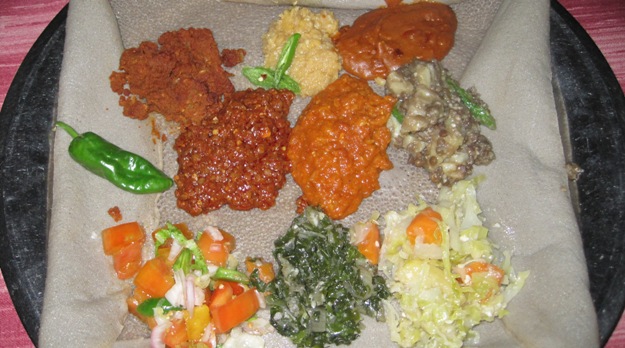When I lived in San Francisco and Los Angeles, if anyone visited me I took them to eat the most exotic food I could think of: Ethiopian food. It always blew them away and why wouldn’t it? What is more exotic than Ethiopian food?
It is heartening to see that the food is similar here and in California, except that here the injera is darker. Injera is the national staple and the basis of Ethiopian food, a thin, spongy, pancake-like, yeasty, soft, wheat-based “bread” that takes days to ferment, which makes it funny that it’s considered fast food.
The injera is rolled out on a platter and a puree or dollops of whatever you order are laid on top and then more injera is used in lieu of utensils. Ethiopians can eat with their hands—their right hands, always—and barely make a mess, while beginning foreigners tend to have food stains up to their elbows.

Even though I have been here over one month, I have two valid excuses about why I don’t know as much about Ethiopian food as I should. First, I arrived the day before the 55-day fast began and meat is hard to find anywhere in Orthodox Christian areas. Most people eat “fasting food” which sounds like a delicious oxymoron, but only means that they abstain from meat and dairy.

Second, I find it hard to order anything other than the beyaynetu (above, costing usually 20-25 birr, or $1.25-$1.50) which is a little bit of everything for the same price as if you had only one item. I’m branching away from beyaynetu as it really isn’t meant to be a one-man show and I always eat alone. Ethiopians rarely eat alone.
If two people order two different things, it will come on one platter for you to share. There is something to be said for eating communally this way. Once I stood longer than I should have and watched a couple eat together. It was lunchtime in a busy cafeteria but it was as if they were alone in a secluded bistro, sharing a tender moment as one would feed the other and the woman would “repair” the base injera by laying another piece in that spot.

The type of wheat used to make injera is a native sand-like grain grown in high altitudes called teff. It is said to have higher nutritional value than wheat and is such a central part of Ethiopian life that there are some panicky rumors that an American group is trying to patent it. If I were Ethiopian I would be more worried that it will run the same path as Bolivian quinoa: westerners discover the health benefits of the grain, demand spikes, and locals are left with sky-high prices. I guess both have the same Doomsday scenario outcome.

Firfir (above) literally means “torn up”. It is pieces of injera mixed with spices or meat and served with more injera, thereby doubling the load.
In Thailand it is always said that sticky rice is great for poor peasants because it supposedly expands in your stomach, making you feel fuller than you are on less food, but I don’t feel it. After eating firfir, however, I am nearly catatonic. If I was pickpocketed right after a dinner of firfir, I would merely burp to the running thief, “It’s all yours, brother.” (Another free business idea from The Dromomaniac!)
There is also the fantastically named fitfit, which is a wetter, less common version of firfir.

This mixed layering of juices is called a spriss (I’ve seen it spelled endless ways). I have to keep reminding myself that avocado (the green stuff pictured) is a fruit, but I am warming up to it. Only here in the east do I come across my favorite, ambeshok (soursop) juice. This costs between 8 and 10 birr ($.50-.60)
When you consider injera’s expanding properties, it makes sense that Ethiopians are not great snackers. There’s very little in the way of snack food here, usually peanuts and packaged junk. As far as “international food” goes, it is largely pasta, pizza and hamburgers, all of which can be pretty good.
Wait, I just discovered the majestic bozena shiro, which is chickpeas in a thick, tomatoey, peppery sauce with tender meat cooked in a clay pot. Ethiopians are absolute masters of chickpeas and lentils.
TheDromomaniac.com
The science & philosophy of one-way travel

Quoting Kent Foster …” In Thailand it is always said that sticky rice is great for poor peasants because it supposedly expands in your stomach, making you feel fuller than you are on less food, but I don’t feel it.”
With the size of your stomach I am not really that surprised to read the above.
Dear Kent:
Please..please …please forgive that last comment. I am ashamed of myself for picking out that one ” small ” defect when instead I should be focusing on all the free business ideas and fantastic travel advice. My only explanation is that I am back on the coffee and may have had a sudden attack of turretts.
I can laugh at last year’s stomach. This year’s model is smaller!
I lived in Bahir Dar, Ethiopia for two years (worked in the local secondary school as a teacher). I loved the place – beautiful scenery, friendly people, and the food was wonderful. Ato Mamu’s Migibet was the best local restaurant. I recently looked at some computer pictures of the current Bahir Dar, and it has exploded into something completely unlike the place when I lived there (from 1967 to 1969). It was a village when I lived there, now it is a big city and becoming a regional capital with an international airport (cows had to be chased off the grass airport in the middle of town when I lived there).
Thanks for sharing your memories! I have a feeling my experience is going to sound like yours soon, the country is changing so much.